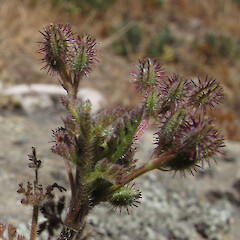Daucus glochidiatus
Common name
New Zealand carrot
Synonyms
Scandix glochidiata Labill., Daucus brachiatus Sieb. in DC.
Family
Apiaceae
Flora category
Vascular – Native
Endemic taxon
Yes
Endemic genus
Yes
Endemic family
No
Structural class
Herbs - Dicotyledons other than Composites
NVS code
The National Vegetation Survey (NVS) Databank is a physical archive and electronic databank containing records of over 94,000 vegetation survey plots - including data from over 19,000 permanent plots. NVS maintains a standard set of species code abbreviations that correspond to standard scientific plant names from the Ngä Tipu o Aotearoa - New Zealand Plants database.
DAUGLO
Chromosome number
2n = 44
Current conservation status
The conservation status of all known New Zealand vascular plant taxa at the rank of species and below were reassessed in 2017 using the New Zealand Threat Classification System (NZTCS) – more information about this can be found on the NZTCS website. This report includes a statistical summary and brief notes on changes since 2012 and replaces all previous NZTCS lists for vascular plants.
Please note, threat classifications are often suggested by authors when publications fall between NZTCS assessment periods – an interim threat classification status has not been assessed by the NZTCS panel.
- Conservation status of New Zealand indigenous vascular plants, 2017 . 2018. Peter J. de Lange, Jeremy R. Rolfe, John W. Barkla, Shannel P. Courtney, Paul D. Champion, Leon R. Perrie, Sarah M. Beadel, Kerry A. Ford, Ilse Breitwieser, Ines Schönberger, Rowan Hindmarsh-Walls, Peter B. Heenan and Kate Ladley. Department of Conservation. Source: NZTCS and licensed by DOC for reuse under the Creative Commons Attribution 4.0 International licence.
2017 | At Risk – Declining | Qualifiers: EF, SO
Previous conservation statuses
2012 | Threatened – Nationally Vulnerable | Qualifiers: EF, SO
2009 | Threatened – Nationally Critical | Qualifiers: SO, DP
2004 | Serious Decline
Distribution
Indigenous. New Zealand: North Island, South Island, Chatham Islands. Also Australia, Tasmania.
Habitat
Coastal, lowland to montane on cliff faces, rock outcrops, talus slopes, in short tussockland or grassland and in open forest.
Detailed description
Erect, usually hispid, yellow-green to dark reddish green, biennial up to 300–800 mm high (annual in harsh conditions), mostly sparingly branched. Stems and branches glabrescent, deeply ribbed or finely striate. Basal leaves flaccid, withering at fruiting, glabrous or sparsely covered in stiff hairs, 2–3-pinnate; petioles 10–150 mm long, expanding toward a ± amplexicaul base, ± glabrous or sparsely covered in stiff hairs (sometimes densely so); primary leaflets in 2–8 pairs, petiolules 4–6 mm long; ultimate segments pinnatisect to pinnatifid, ovate, linear-oblong, linear-spathulate, apices mucronulate. Stem leaves similar but reduced. Umbels axillary and terminal, irregularly compound or simple in stressed specimens, on slender or stout hispid peducles up to 170 mm long. Rays 1–11, unequal, primarly up to 160 mm long, secondary up to 15 mm long; bracts (0)–2–5, linear, entire or deeply incised, sometimes pinnatisect, caducous; bracteoles 0–5, simple, linear. Flowers 1–10, c. 1 mm diameter, petals white, dirty white or tinged red, withering early and shedding. Fruit ellipsoid, dark brown to red-brown (rarely pale brown), 3–5 mm long; primary ribs sparsely to moderately ciliate; secondary ribs glochidiate, glochidia ± 1 mm long, apices capped.
Similar taxa
Reduced, stressed plants of wild carrot (Daucus carota) are frequently confused with native carrot. Wild carrot differs from native carrot by its usually taller stature (up to 1.3 m tall), by the regular umbels that are concave at fruiting, and by the more numerous rays. Species of the naturalised genus Torilis (hedge parsley) are also frequently confused with native carrot. Torilis is separated from Daucus by the floral bracts which are either absent or simple, mostly subsessile umbels bearing 2–5 rays, or pedunculate umbels with 2–12 more or less unequal rays. In comparison to wild carrot, Torilis plants are usually much taller (up to 2 m tall) and rather leafier, with the leaves much larger and less divided.
Flowering
September–February
Flower colours
Red/Pink, White
Fruiting
November–June
Life cycle
Spiny mericarps are dispersed by attachment (Thorsen et al., 2009)
Propagation technique
Easily grown from fresh seed. Resents root disturbance so should be sown where it is wanted. Does best in a free-draining, open situation. Treat as an annual.
Threats
This species appears to have undergone a rapid decline over the last 30 years and is now extinct over large parts of its former range. The reason for this decline is not clear though it is likely that competition from faster growing, taller weeds, particularly rat’s tail grass (Sporobolus africanus) is a key factor. Rat’s tail now dominates most of the northern North Island habitats that used to support native carrot.
Etymology
daucus: An ancient Greek name
glochidiatus: Barbed
Where To Buy
Not commercially available.
Attribution
Description based on herbarium specimens.
References and further reading
Thorsen MJ, Dickinson KJM, Seddon PJ. 2009. Seed dispersal systems in the New Zealand flora. Perspectives in Plant Ecology, Evolution and Systematics 11: 285–309. https://doi.org/10.1016/j.ppees.2009.06.001.






















